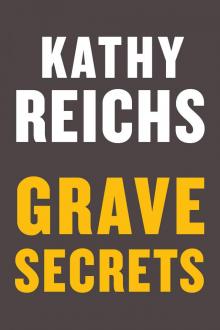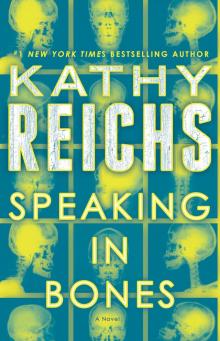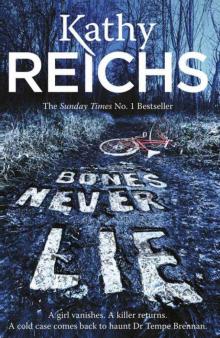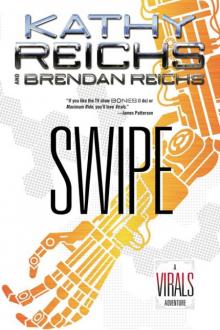- Home
- Kathy Reichs
Déjà Dead Page 3
Déjà Dead Read online
Page 3
THE NEXT DAY BEGAN AS WARM AND SUNNY AS ITS PREDECESSOR, A fact that would normally draw me into high spirits. I am a woman whose moods are influenced by the weather, my outlook rising and falling with the barometer. But that day the weather would be irrelevant. By 9 A.M. I was already in autopsy room 4, the smallest of the suites at the Laboratoire de Médecine Légale, and one that is specially outfitted for extra ventilation. I often work here since most of my cases are less than perfectly preserved. But it’s never fully effective. Nothing is. The fans and disinfectants never quite win over the smell of ripened death. The antiseptic gleam of the stainless steel never really eradicates the images of human carnage.
The remains recovered at Le Grand Séminaire definitely qualified for room 4. After a quick dinner the previous evening, I’d gone back to the grounds and we’d processed the site. The bones were at the morgue by 9:30 P.M. Now they lay in a body bag on a gurney to my right. Case #26704 had been discussed at the morning staff meeting. Following standard procedure, the body had been assigned to one of the five pathologists working at the lab. Since the corpse was largely skeletonized, the little soft tissue that remained far too decomposed for standard autopsy, my expertise was requested.
One of the autopsy technicians had called in sick this morning, leaving us shorthanded. Bad timing. It’d been a busy night: a teenage suicide, an elderly couple found dead in their home, and a car fire victim charred beyond recognition. Four autopsies. I’d offered to work alone.
I was dressed in green surgical scrubs, plastic goggles, and latex gloves. Fetching. I’d already cleaned and photographed the head. It would be X-rayed this morning, then boiled to remove the putrefied flesh and brain tissue so that I could do a detailed examination of the cranial features.
I’d painstakingly examined the hair, searching for fibers or other trace evidence. As I separated the damp strands, I couldn’t help imagining the last time the victim had combed it, wondering if she’d been pleased, frustrated, indifferent. Good hair day. Bad hair day. Dead hair day.
Suppressing these thoughts, I bagged the sample and sent it up to biology for microscopic analysis. The plunger and plastic bags had also been turned over to the Laboratoire des Sciences Judiciaires where they’d be checked for prints, traces of bodily fluids, or other minuscule indicators of killer or victim.
Three hours on our hands and knees the previous night feeling through mud, combing through grass and leaves, and turning over rocks and logs had yielded nothing else. We’d searched until darkness closed us down, but came away empty. No clothing. No shoes. No jewelry. No personal effects. The crime scene recovery team would return to dig and sift today, but I doubted they’d find anything. I would have no manufacturer’s tags or labels, no zippers or buckles, no jewelry, no weapons or bindings, no slashes or entrance holes in clothing to corroborate my findings. The body had been dumped, naked and mutilated, stripped of everything that linked it to a life.
I returned to the body bag for the rest of its grisly contents, ready to start my preliminary examination. Later, the limbs and torso would be cleaned, and I would do a complete analysis of all the bones. We’d recovered almost the whole skeleton. The killer had made that task easier. As with the head and torso, he, or she, had placed the arms and legs in separate plastic bags. There were four in all. Very tidy. Packaged and discarded like last week’s garbage. I filed the outrage in another place and forced myself to concentrate.
I removed the dismembered segments and arranged them in anatomical order on the stainless steel autopsy table in the middle of the room. First, I transferred the torso and centered it, breast side up. It held together reasonably well. Unlike the bag holding the head, those containing the body parts had not stayed tightly sealed. The torso was in the worst shape, the bones held together only by leatherized bands of dried muscle and ligament. I noted that the uppermost vertebrae were missing, and hoped I’d find them attached to the head. Except for traces, the internal organs were long gone.
Next, I placed the arms to the sides and the legs below. The limbs hadn’t been exposed to sunlight, and weren’t as desiccated as the chest and abdomen. They retained large portions of putrefied soft tissue. I tried to ignore the seething blanket of pale yellow that made a languid, wavelike retreat from the surface of each limb as I withdrew it from the body bag. Maggots will abandon a corpse when exposed to light. They were dropping from the body to the table, from the table to the floor, in a slow but steady drizzle. Pale yellow grains of rice lay writhing by my feet. I avoided stepping on them. I’d never really gotten used to them.
I reached for my clipboard and began to fill in the form. Name: Inconnu. Unknown. Date of autopsy: June 3, 1994. Investigators: Luc Claudel, Michel Charbonneau, Section des homicides, CUM. Homicide division, Montreal Urban Community Police.
I added the police report number, the morgue number, and the Laboratoire de Médecine Légale, or LML, number and experienced my usual wave of anger at the arrogant indifference of the system. Violent death allows no privacy. It plunders one’s dignity as surely as it has taken one’s life. The body is handled, scrutinized, and photographed, with a new series of digits allocated at each step. The victim becomes part of the evidence, an exhibit, on display for police, pathologists, forensic specialists, lawyers, and, eventually, jurors. Number it. Photograph it. Take samples. Tag the toe. While I am an active participant, I can never accept the impersonality of the system. It is like looting on the most personal level. At least I would give this victim a name. Death in anonymity would not be added to the list of violations he or she would suffer.
I selected a form from those on the clipboard. I’d alter my normal routine and leave the full skeletal inventory for later. For now the detectives wanted only the ID profile: sex, age, and race.
Race was pretty straightforward. The hair was red, what skin remained appeared fair. Decomposition, however, could do strange things. I’d check the skeletal details after cleaning. For now Caucasoid seemed a safe bet.
I already suspected the victim was female. The facial features were delicate, the overall body build slight. The long hair meant nothing.
I looked at the pelvis. Turning it to the side I noted that the notch below the hip blade was broad and shallow. I repositioned it so that I could see the pubic bones, the region in front where the right and left halves of the pelvis meet. The curve formed by their lower borders was a wide arch. Delicate raised ridges cut across the front of each pubic bone, creating distinct triangles in the lower corners. Typical female features. Later I’d take measurements and run discriminant function analyses on the computer, but I had no doubt these were the remains of a woman.
I was wrapping the pubic area in a wet rag when the sound of the phone startled me. I hadn’t realized how quiet it was. Or how tense I was. I walked to the desk, zigzagging through maggots like a child playing jacks.
“Dr. Brennan,” I answered, pushing the goggles to the top of my head and dropping into the chair. Using my pen, I flicked a maggot from the desktop.
“Claudel,” a voice said. One of the two CUM detectives assigned to the case. I looked at the wall clock—ten-forty. Later than I realized. He didn’t go on. Obviously he assumed his name was message enough.
“I’m working on her right now,” I said. I could hear a metallic grating sound. “I shou—”
“Elle?” he interrupted. Female?
“Yes.” I watched another maggot contract into a crescent, then double back on itself and repeat the maneuver in the opposite direction. Not bad.
“White?”
“Yes.”
“Age?”
“I should be able to give you a range within an hour.”
I could picture him looking at his watch.
“Okay. I’ll be there after lunch.” Click. It was a statement, not a request. Apparently it didn’t matter if it was okay with me.
I hung up and returned to the lady on the table. Picking up the clipboard, I flipped to the next page on the repo
rt form. Age. This was an adult. Earlier, I’d checked her mouth. The wisdom teeth were fully erupted.
I examined the arms where they’d been detached at the shoulders. The end of each humerus was fully formed. I could see no line demarcating a separate cap on either side. The other ends were useless—they had been cleanly severed just above the wrists. I’d have to find those fragments later. I looked at the legs. The head of the femur was also completely formed on both right and left.
Something about those severed joints disturbed me. It was a feeling apart from the normal reaction to depravity, but it was vague, ill-formed. As I allowed the left leg to settle back onto the table my guts felt like ice. The cloud of dread that first touched me in the woods returned. I shook it off and forced myself to focus on the question at hand. Age. Fix the age. A correct age estimate can lead to a name. Nothing else will matter until she has a name.
I used a scalpel to peel back the flesh around the knee and elbow joints. It came away easily. Here, too, the long bones were fully mature. I’d verify this on X ray, but knew it meant bone growth had been completed. I saw no lipping or arthritic change in the joints. Adult, but young. It was consistent with the lack of wear I’d observed on the teeth.
But I wanted more precision. Claudel would expect it. I looked at each collarbone where it met the sternum at the base of the throat. Though the one on the right was detached, the joint surface was encased in a hard knot of dried cartilage and ligament. Using a scissors, I snipped away as much of the leathery tissue as I could, then wrapped the bone in another wet rag. I returned my attention to the pelvis.
I removed that rag and, again using a scalpel, began gently sawing through the cartilage connecting the two halves in front. Wetting it down had made it more pliable, easier to cut, but still the process was slow and tedious. I didn’t want to risk damaging the underlying surfaces. When the pubic bones were finally separate, I cut the few strips of dried muscle uniting the pelvis to the lower end of the spine in back, freed it, carried it to the sink, and submerged the pubic portion in water.
Next I returned to the body and unwrapped the collarbone. Again, I teased off as much tissue as possible. Then I filled a plastic specimen container with water, positioned it against the rib cage, and stuck the end of the clavicle in it.
I glanced at the wall clock—12:25 P.M. Stepping back from the table, I peeled off my gloves and straightened. Slowly. My back felt like a Pop Warner league had been practicing on it. I placed my hands on my hips and stretched, arching backward and rotating my upper body. It didn’t really relieve the pain, but it didn’t hurt either. My spine seemed to hurt a lot lately, and bending over an autopsy table for three hours tended to aggravate it. I refused to believe or admit it was age-related. My newly discovered need for reading glasses and the seemingly permanent upgrade from 115 to 120 in my weight were likewise not the result of aging. Nothing was.
I turned to see Daniel, one of the autopsy technicians, watching from the outer office. A tic pulled his upper lip, and his eyes pinched shut momentarily. With a jerk he shifted, placing all his weight on one leg and cocking the other. He looked like a sandpiper waiting out a wave.
“When would you like me to do the radiography?” he asked. His glasses rode low on his nose and he seemed to peer over rather than through them.
“I should finish up by three,” I said, tossing my gloves into the biological waste receptacle. I suddenly realized how hungry I was. My morning coffee sat on the counter, cold and untouched. I’d completely forgotten it.
“Okay.” He hopped backward, pivoted, and disappeared down the hall.
I flipped the goggles onto the counter, withdrew a white paper sheet from a drawer below the side counter, unfolded it, and covered the body. After washing my hands I returned to my office on the fifth floor, changed into street clothes, and went out for lunch. This was rare for me, but today I needed the sunshine.
• • •
Claudel was true to his word. When I returned at one-thirty he was already in my office. He sat opposite my desk, his attention focused on the reconstructed skull on my worktable. He turned his head when he heard me, but said nothing. I hung my coat on the back of the door and moved past him and into my chair.
“Bonjour, Monsieur Claudel. Comment ça va?” I smiled at him across my desk.
“Bonjour.” Apparently, he was uninterested in how I was doing. Okay. I waited. I would not succumb to his charm.
A folder lay on the desk in front of him. He placed his hand on it and looked at me. His face brought to mind a parrot. The features angled sharply from his ears to the midline, plunging forward into a beaklike nose. Along this apex his chin, his mouth, and the tip of his nose pointed downward in a series of V’s. When he smiled, which was rare, the V of his mouth sharpened, and the lips drew in, rather than back.
He sighed. He was being very patient with me. I hadn’t worked with Claudel before, but knew his reputation. He thought himself an exceptionally intelligent man.
“I have several names,” he said. “Possibles. They all disappeared within the last six months.”
We’d already discussed the question of time since death. My morning’s work hadn’t changed my mind. I was certain she’d been dead less than three months. That would place the murder in March or later. Winters are cold in Quebec, hard on the living but kind to the dead. Frozen bodies do not decay. Nor do they attract bugs. Had she been dumped last fall, before the onset of winter, there would’ve been signs of insect infestation. The presence of casings or larvae would’ve indicated an aborted fall invasion. There were none. Given that it had been a warm spring, the abundance of maggots and the degree of deterioration were consistent with an interval of three months or less. The presence of connective tissue along with the virtual absence of viscera and brain matter also suggested a late winter, early spring death.
I leaned back and looked at him expectantly. I could be cagey too. He opened the folder and thumbed through its contents. I waited.
Selecting one of the forms, he read, “Myriam Weider.” There was a pause as he sifted through the information on the form. “Disappeared April 4, 1994.” Pause. “Female. White.” Long pause. “Date of birth 9/6/48.”
We both calculated mentally—forty-five years old.
“Possible,” I said, gesturing with my hand for him to go on.
He laid the form on the desk and read from the next. “Solange Leger. Reported missing by the husband,” he paused, straining to make out the date, “May 2, 1994. Female. White. Date of birth 8/17/28.”
“No.” I shook my head. “Too old.”
He placed the form at the back of the folder and selected another. “Isabelle Gagnon. Last seen April 1, 1994. Female. White. Date of birth 1/15/71.”
“Twenty-three. Yeah.” I nodded slowly. “Possible.” It went on the desk.
“Suzanne St. Pierre. Female. Missing since March 9, 1994.” His lips moved as he read. “Failed to return from school.” He paused, calculating on his own. “Age sixteen. Jesus Christ.”
Again I shook my head. “She’s too young. This isn’t a kid.”
He frowned, pulling out the last form. “Evelyn Fontaine. Female. Age thirty-six. Last seen in Sept Îles on March 28. Oh yeah. She’s an Innu.”
“Doubtful,” I said. I didn’t think the remains were those of an Indian.
“That’s it,” he said. There were two forms on the desk. Myriam Weider, age forty-five, and Isabelle Gagnon, age twenty-three. Maybe one of them was lying downstairs in room 4. Claudel looked at me. His eyebrows rose in the middle forming yet another V, this one inverted.
“How old was she?” he asked, emphasizing the verb and his long-suffering patience.
“Let’s go downstairs and see.” That’ll bring a little sunshine into your day, I thought.
It was petty but I couldn’t help it. I knew Claudel’s reputation for avoiding the autopsy room, and I wanted to discomfort him. For a moment he looked trapped. I enjoyed his unease. Grabbin
g a lab coat from the hook on the door, I hurried down the hall and inserted my key for the elevator. He was silent as we descended. He looked like a man on the way to a prostate exam. Claudel rarely rode this elevator. It stopped only at the morgue.
• • •
The body lay undisturbed. I gloved and removed the white sheet. From the corner of my eye I could see Claudel framed in the doorway. He’d entered the room just far enough to be able to say he’d been there. His eyes wandered over the steel countertops, the glass-fronted cabinets with their stock of clear plastic containers, the hanging scale, everything but the body. I’d seen it before. Photographs were no threat. The blood and gore were somewhere else. Distant. The murder scene was a clinical exercise. No problem. Dissect it, study it, solve the puzzle. But place a body on an autopsy table and it was a different matter. Claudel had put his face in neutral, hoping to look calm.
I removed the pubic bones from the water and gently pried them apart. Using a probe, I teased around the edges of the gelatinous sheath that covered the right pubic face. Gradually it loosened its hold and came away. The underlying bone was marked with deep furrows and ridges coursing horizontally across its surface. A sliver of solid bone partially framed the outer margin, forming a delicate and incomplete rim around the pubic face. I repeated the process on the left. It was identical.
Claudel hadn’t moved from the doorway. I carried the pelvis to the Luxolamp, pulled the extensor arm toward me, and pressed the switch. Fluorescent light illuminated the bone. Through the round magnifying glass, details appeared that hadn’t been apparent to the naked eye. I looked at the uppermost curve of each hipbone and saw what I’d been expecting.

 Two Nights
Two Nights The Bone Collection: Four Novellas
The Bone Collection: Four Novellas Fatal Voyage
Fatal Voyage 206 Bones
206 Bones Bones to Ashes
Bones to Ashes Terminal
Terminal Monday Mourning
Monday Mourning Flash and Bones
Flash and Bones Cross Bones
Cross Bones Devil Bones
Devil Bones Break No Bones
Break No Bones Swamp Bones
Swamp Bones Déjà Dead
Déjà Dead Shock
Shock Spider Bones
Spider Bones Death Du Jour
Death Du Jour Grave Secrets
Grave Secrets Trace Evidence: A Virals Short Story Collection
Trace Evidence: A Virals Short Story Collection Bones on Ice
Bones on Ice The Bone Code
The Bone Code Bones in Her Pocket
Bones in Her Pocket Seizure:
Seizure: Speaking in Bones
Speaking in Bones Deadly Decisions
Deadly Decisions Spike
Spike Bones Never Lie
Bones Never Lie Bones of the Lost
Bones of the Lost Virals 03.5 - Swipe
Virals 03.5 - Swipe Exposure
Exposure A Conspiracy of Bones
A Conspiracy of Bones Shift (tory brennan)
Shift (tory brennan) Bones of the Lost: A Temperance Brennan Novel tb-16
Bones of the Lost: A Temperance Brennan Novel tb-16 Virals tb-1
Virals tb-1 Bones Are Forever tb-15
Bones Are Forever tb-15 Code tb-3
Code tb-3 Seizure tb-2
Seizure tb-2 Deadly Descisions
Deadly Descisions Spider Bones: A Novel
Spider Bones: A Novel